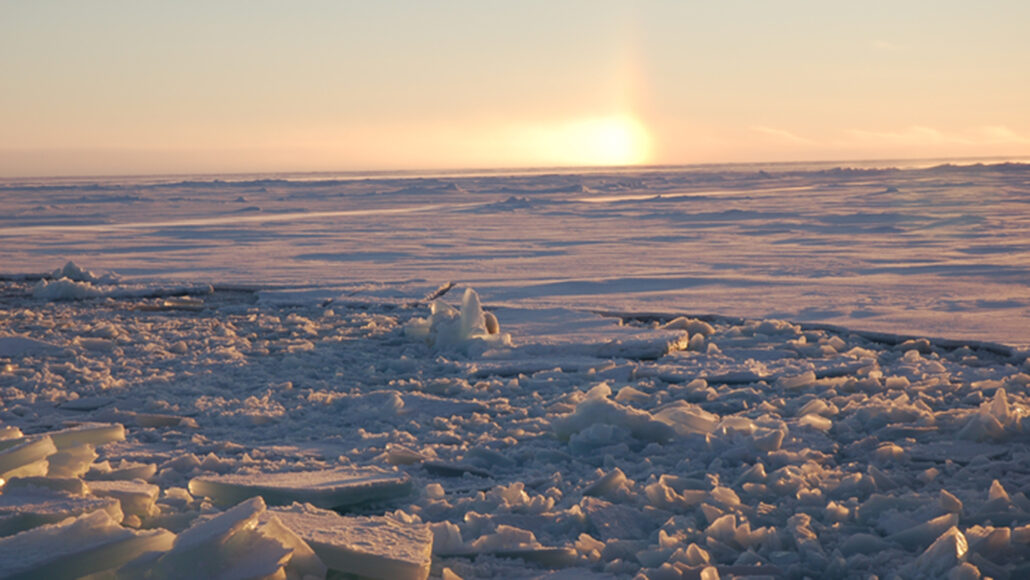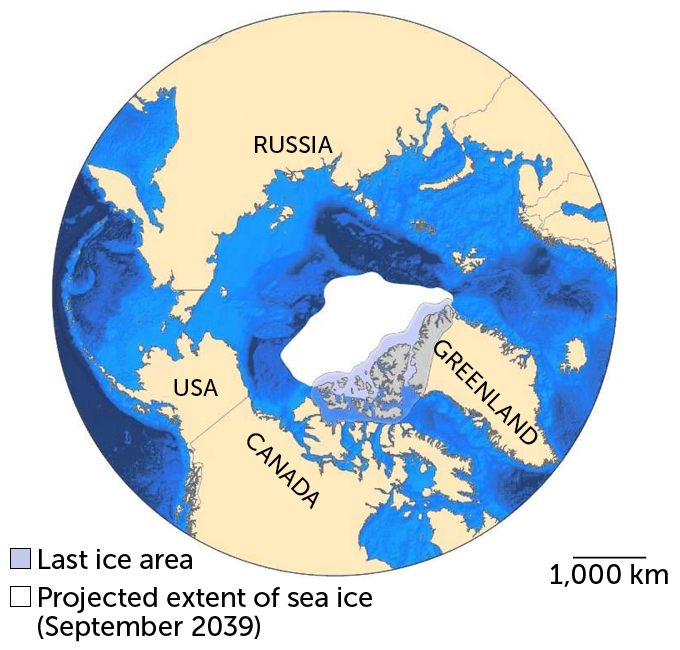The goal to preserve summer sea ice, and the creatures that depend on it, is ambitious

Scientists are pinning their hopes on building a sanctuary for Arctic species in the Last Ice Area (seen here), the region of the Arctic where summer sea ice will last longest.
ROBERT NEWTON/LAMONT-DOHERTY EARTH OBSERVATORY
By Freda Kreier
NOVEMBER 15, 2021
It started with polar bears.
In 2012, polar bear DNA revealed that the iconic species had faced extinction before, likely during a warm period 130,000 years ago, but had rebounded. For researchers, the discovery led to one burning question: Could polar bears make a comeback again?
Studies like this one have emboldened an ambitious plan to create a refuge where Arctic, ice-dependent species, from polar bears down to microbes, could hunker down and wait out climate change. For this, conservationists are pinning their hopes on a region in the Arctic dubbed the Last Ice Area — where ice that persists all summer long will survive the longest in a warming world.
Here, the Arctic will take its last stand. But how long the Last Ice Area will hold on to its summer sea ice remains unclear. A computer simulation released in September predicts that the Last Ice Area could retain its summer sea ice indefinitely if emissions from fossil fuels don’t warm the planet more than 2 degrees Celsius above preindustrial levels, which is the goal set by the 2015 Paris Climate Agreement (SN: 12/12/15). But a recent report by the United Nations found that the climate is set to warm 2.7 degrees Celsius by 2100 under current pledges to reduce emissions, spelling the end of the Arctic’s summer sea ice (SN: 10/26/21).
Nevertheless, some scientists are hoping that humankind will rally to curb emissions and implement technology to capture carbon and other greenhouse gases, which could reduce, or even reverse, the effects of climate change on sea ice. In the meantime, the Last Ice Area could buy ice-dependent species time in the race against extinction, acting as a sanctuary where they can survive climate change, and maybe one day, make their comeback.
Ecosystem of the frozen sea
The Last Ice Area is a vast floating landscape of solid ice extending from the northern coast of Greenland to Canada’s Banks Island in the west. This region, roughly the length of the West Coast of the United States, is home to the oldest and thickest ice in the Arctic, thanks to an archipelago of islands in Canada’s far north that prevents sea ice from drifting south and melting in the Atlantic.
As sea ice from others part of the Arctic rams into this natural barrier, it piles up, forming long towering ice ridges that run for kilometers across the frozen landscape. From above, the area appears desolate. “It’s a pretty quiet place,” says Robert Newton, an oceanographer at Columbia University and coauthor of the recent sea ice model, published September 2 in Science. “A lot of the life is on the bottom of the ice.”
The muddy underbelly of icebergs is home to plankton and single-celled algae that evolved to grow directly on ice. These species form the backbone of an ecosystem that feeds everything from tiny crustaceans all the way up to beluga whales, ringed seals and polar bears.
These plankton and algae species can’t survive without ice. So as summer sea ice disappears across the Arctic, the foundation of this ecosystem is literally melting away. “Much of the habitat Arctic species depend on will become uninhabitable,” says Brandon Laforest, an Arctic expert at World Wildlife Fund Canada in Montreal. “There is nowhere else for these species to go. They’re literally being squeezed into the Last Ice Area.”

The Last Ice Area extends across national borders, making it especially challenging to protect the last summer sea ice in the Arctic. The extent of the ice is predicted to shrink considerably by 2039.WWF CANADA
The last stronghold of summer ice provides an opportunity to create a floating sanctuary —an Arctic ark if you will — for the polar bears and many other species that depend on summer ice to survive. For over a decade, WWF Canada and a coalition of researchers and Indigenous communities have lobbied for the area to be protected from another threat: development by industries that may be interested in the region’s oil and mineral resources.
“The tragedy would be if we had an area where these animals could survive this bottleneck, but they don’t because it’s been developed commercially,” Newton says.
But for Laforest, protecting the Last Ice Area is not only a question of safeguarding arctic creatures. Sea ice is also an important tool in climate regulation, as the white surface reflects sunlight back into space, helping to cool the planet. In a vicious cycle, losing sea ice helps speed up warming, which in turn melts more ice.
And for the people who call the Arctic home, sea ice is crucial for food security, transportation and cultural survival, wrote Inuit Circumpolar Council Chair Okalik Eegeesiak in a 2017 article for the United Nations. “Our entire cultures and identity are based on free movement on land, sea ice and the Arctic Ocean,” Eegeesiak wrote. “Our highway is sea ice.”
The efforts of these groups have borne some fruit. In 2019, the Canadian government moved to set aside nearly a third of the Last Ice Area as protected spaces called marine preserves. Until 2024, all commercial activity within the boundaries of the preserves is forbidden, with provisions for Indigenous peoples. Conservationists are now asking these marine preserves to be put under permanent protection.
Rifts in the ice
However, there are some troubling signs that the sea ice in the region is already precarious. Most worrisome was the appearance in May 2020 of a Rhode Island—sized rift in the ice at the heart of the Last Ice Area. Kent Moore, a geophysicist at the University of Toronto, says that these unusual events may become more frequent as the ice thins. This suggests that the Last Ice Area may not be as resilient as we thought, he says.
This is something that worries Laforest. He and others are skeptical that reversing climate change and repopulating the Arctic with ice-dependent species will be possible. “I would love to live in a world where we eventually reverse warming and promote sea ice regeneration,” he says. “But stabilization seems like a daunting task on its own.”
Still, hope remains. “All the models show that if you were to bring temperatures back down, sea ice will revert to its historical pattern within several years,” says Newton.
To save the last sea ice — and the creatures that depend on it — removing greenhouse gases from the atmosphere will be essential, says oceanographer Stephanie Pfirman of Arizona State University in Tempe, who coauthored the study on sea ice with Newton. Technology to capture carbon, and prevent more carbon from entering the atmosphere, already exists. The largest carbon capture plant is in Iceland, but projects like that one have yet to be implemented on a major scale.
Without such intervention, the Arctic is set to lose the last of its summer ice before the end of the century. It would mean the end of life on the ice. But Pfirman, who suggested making the Last Ice Area a World Heritage Site in 2008, says that humankind has undergone big economic and social changes — like the kind needed to reduce emissions and prevent warming — in the past. “I was in Germany when the [Berlin] wall came down, and people hadn’t expected that to happen,” she says.
Protecting the Last Ice Area is about buying time to protect sea ice and species, says Pfirman. The longer we can hold on to summer sea ice, she says, the better chance we have at bringing arctic species —from plankton to polar bears — back from the brink.
The last stronghold of summer ice provides an opportunity to create a floating sanctuary —an Arctic ark if you will — for the polar bears and many other species that depend on summer ice to survive. For over a decade, WWF Canada and a coalition of researchers and Indigenous communities have lobbied for the area to be protected from another threat: development by industries that may be interested in the region’s oil and mineral resources.
“The tragedy would be if we had an area where these animals could survive this bottleneck, but they don’t because it’s been developed commercially,” Newton says.
But for Laforest, protecting the Last Ice Area is not only a question of safeguarding arctic creatures. Sea ice is also an important tool in climate regulation, as the white surface reflects sunlight back into space, helping to cool the planet. In a vicious cycle, losing sea ice helps speed up warming, which in turn melts more ice.
And for the people who call the Arctic home, sea ice is crucial for food security, transportation and cultural survival, wrote Inuit Circumpolar Council Chair Okalik Eegeesiak in a 2017 article for the United Nations. “Our entire cultures and identity are based on free movement on land, sea ice and the Arctic Ocean,” Eegeesiak wrote. “Our highway is sea ice.”
The efforts of these groups have borne some fruit. In 2019, the Canadian government moved to set aside nearly a third of the Last Ice Area as protected spaces called marine preserves. Until 2024, all commercial activity within the boundaries of the preserves is forbidden, with provisions for Indigenous peoples. Conservationists are now asking these marine preserves to be put under permanent protection.
Rifts in the ice
However, there are some troubling signs that the sea ice in the region is already precarious. Most worrisome was the appearance in May 2020 of a Rhode Island—sized rift in the ice at the heart of the Last Ice Area. Kent Moore, a geophysicist at the University of Toronto, says that these unusual events may become more frequent as the ice thins. This suggests that the Last Ice Area may not be as resilient as we thought, he says.
This is something that worries Laforest. He and others are skeptical that reversing climate change and repopulating the Arctic with ice-dependent species will be possible. “I would love to live in a world where we eventually reverse warming and promote sea ice regeneration,” he says. “But stabilization seems like a daunting task on its own.”
Still, hope remains. “All the models show that if you were to bring temperatures back down, sea ice will revert to its historical pattern within several years,” says Newton.
To save the last sea ice — and the creatures that depend on it — removing greenhouse gases from the atmosphere will be essential, says oceanographer Stephanie Pfirman of Arizona State University in Tempe, who coauthored the study on sea ice with Newton. Technology to capture carbon, and prevent more carbon from entering the atmosphere, already exists. The largest carbon capture plant is in Iceland, but projects like that one have yet to be implemented on a major scale.
Without such intervention, the Arctic is set to lose the last of its summer ice before the end of the century. It would mean the end of life on the ice. But Pfirman, who suggested making the Last Ice Area a World Heritage Site in 2008, says that humankind has undergone big economic and social changes — like the kind needed to reduce emissions and prevent warming — in the past. “I was in Germany when the [Berlin] wall came down, and people hadn’t expected that to happen,” she says.
Protecting the Last Ice Area is about buying time to protect sea ice and species, says Pfirman. The longer we can hold on to summer sea ice, she says, the better chance we have at bringing arctic species —from plankton to polar bears — back from the brink.
No comments:
Post a Comment